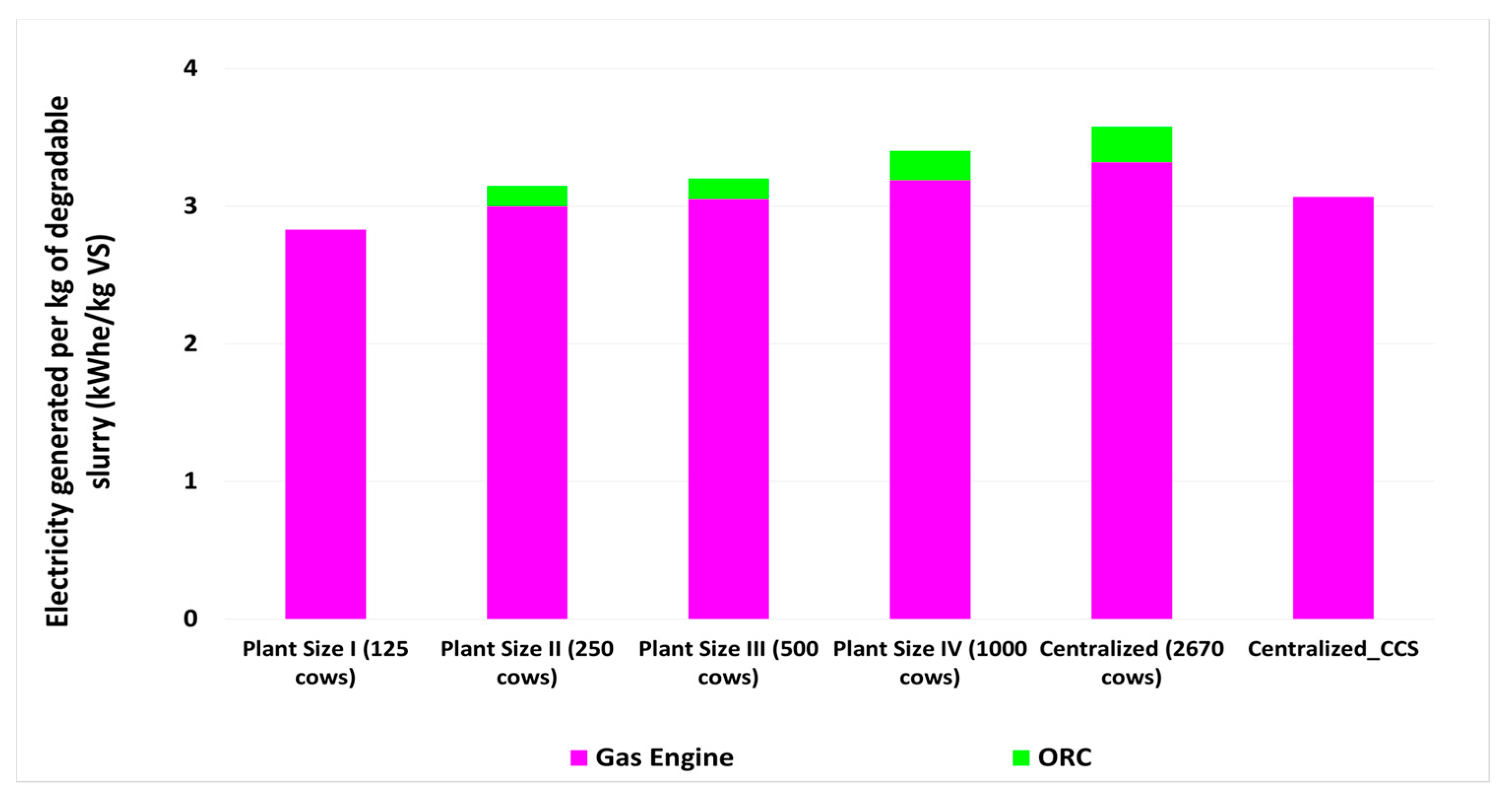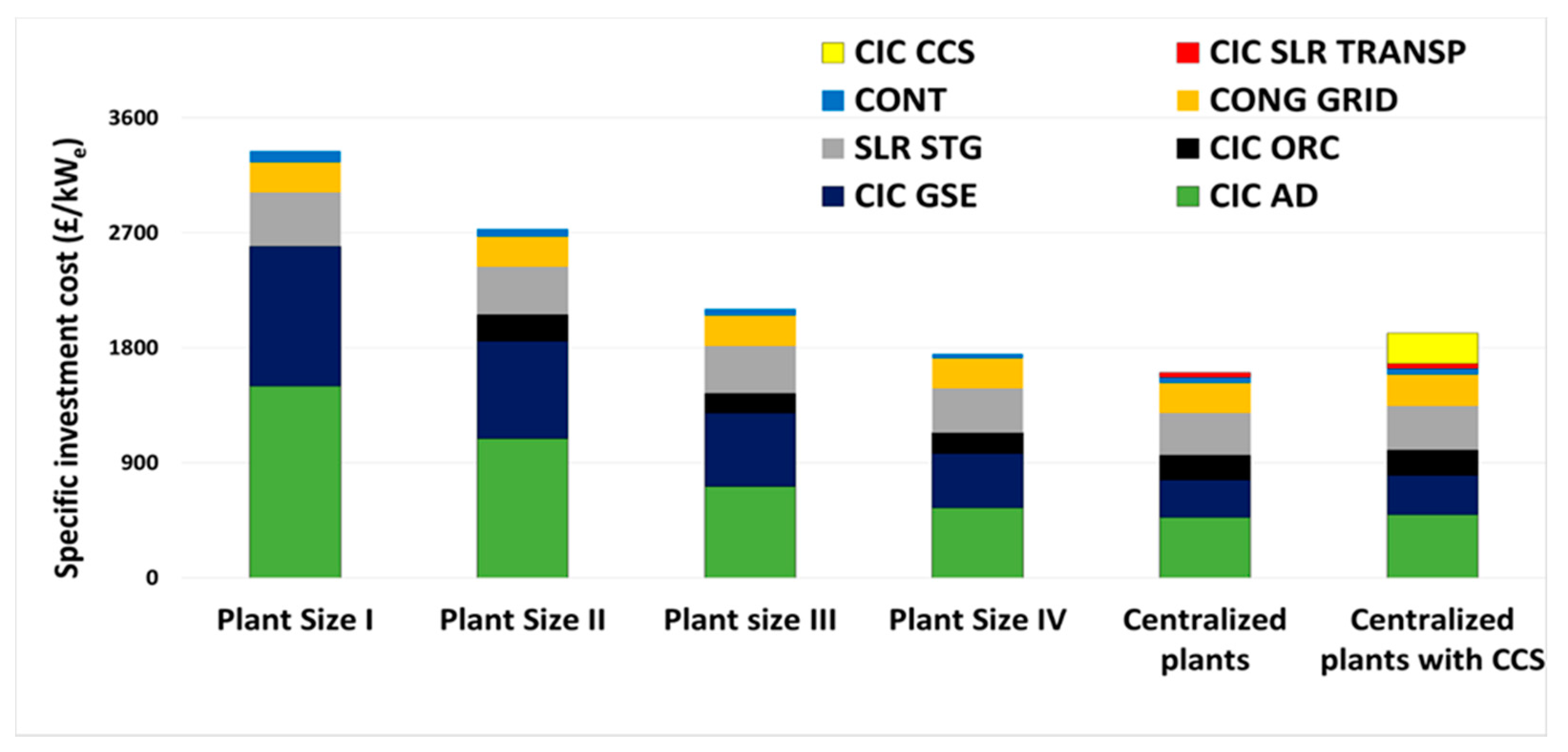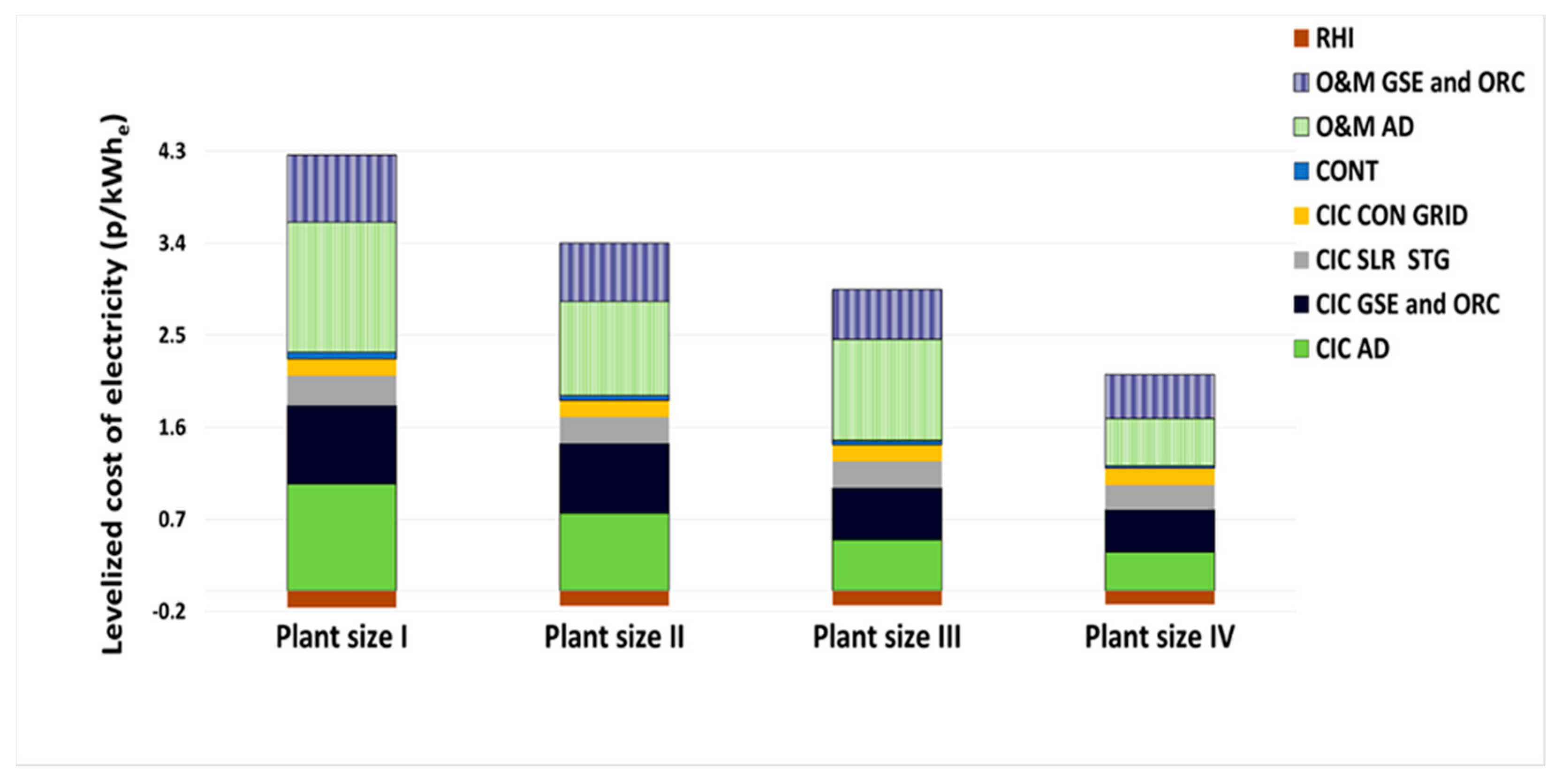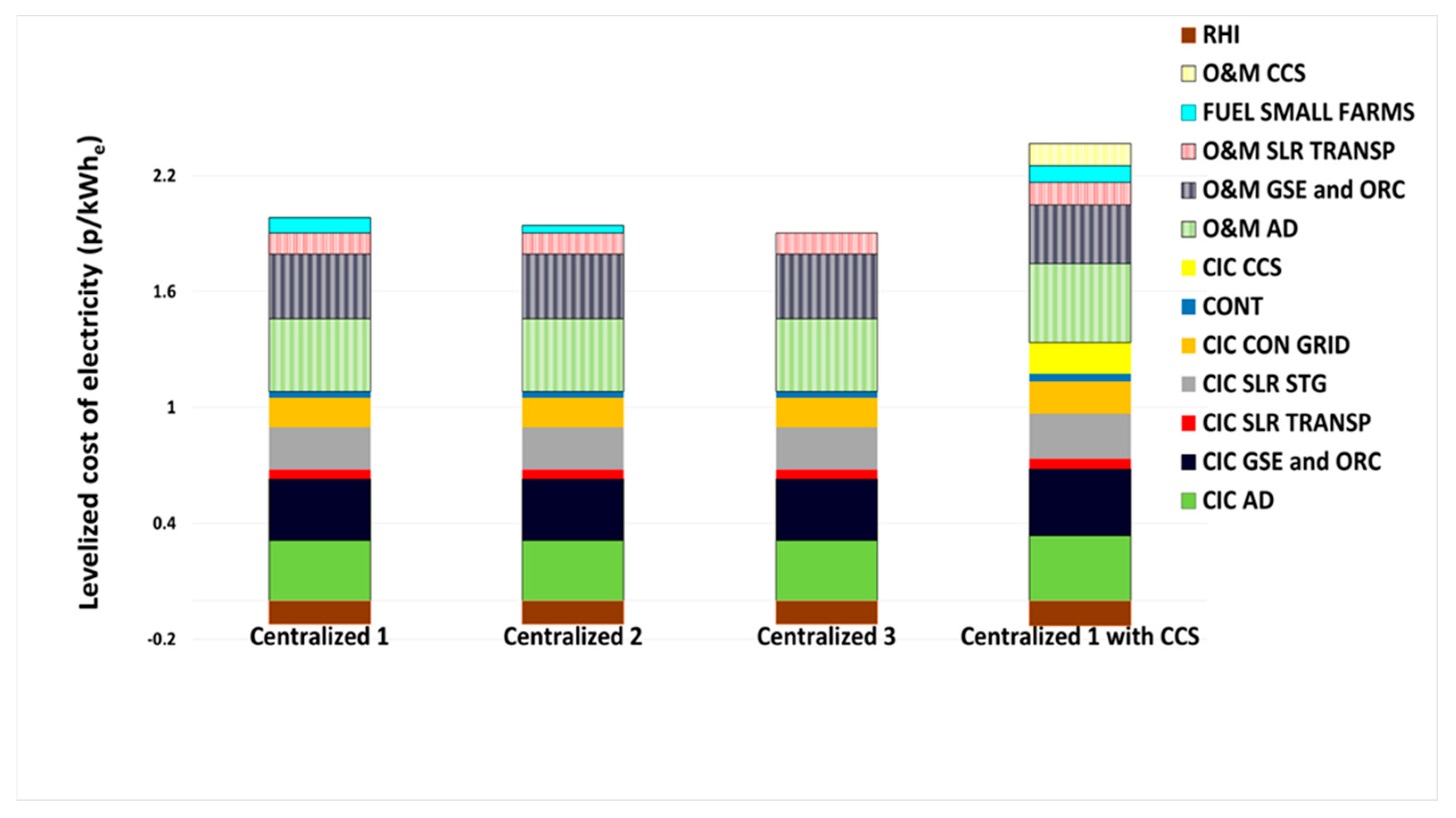Potential for Energy Production from Farm Wastes Using Anaerobic Digestion in the UK: An Economic Comparison of Different Size Plants
Abstract
:1. Introduction
2. Methodology
2.1. Farm Sizes and Bio-Gas Yield
2.2. Power Generation Using Gas Engine and Organic Rankine Cycle Systems
3. Results
3.1. Technical Indicators
3.2. Economic Indicators
4. Discussions
5. Conclusions
- For the larger scale plants, a larger electrical efficiency was observed which led to higher power production per mass of bio-degradable waste and a lower levelized cost of electricity for AD power plants.
- The combination of the slurry from different farms for AD and power generation in centralized, large capacity systems enables more efficient heat and power generation that increases the economic viability of these systems.
- Analysis of the techno-economic feasibility of the introduction of CO2 capture and storage processes in AD-based electricity generation showed that it is possible to achieve negative CO2 emission power production with the potential for economic benefits helped by incentives currently on offer in the UK.
Acknowledgments
Author Contributions
Conflicts of Interest
Nomenclature
| Abbreviation | Meaning |
| AD | Anaerobic Digestion. |
| Anaerobic Digester (reactor volume) | |
| CEPCI | Chemical Engineering Plant Cost Index |
| CIC | Capital investment cost (£/kWe) |
| CCS | Carbon capture and storage |
| CON GRID | Connection to the grid |
| CONT | Contingency and engineering costs (£) |
| DEFRA | UK Department of Environment, Food and Rural Affairs |
| FUEL TRANSP | Fuel transport |
| GSE | Gas engine |
| hp | Horse power |
| HDPE | High-density polyethylene |
| L | Litter |
| MEA | Mono-ethanol amine |
| LCOE | Levelized cost of electricity(£/kWh) |
| O&M | Operation and maintenance costs (£/year) |
| ORC | Organic Rankine cycle |
| p | Pence |
| Power output gas engine (kWe) | |
| Power output organic Rankine cycle(kWe) | |
| PSA | Pressure swing adsorption |
| r | Discount/interest rate for the estimation of levelized cost of electricity (Equation (7)) |
| RHI | Renewable heat incentive |
| SIC | Specific investment cost (£/kWe) |
| SLR.STG | Slurry storage |
| SLR.TRANSP. | Slurry transport |
| VS | Volatile solid content in the slurry |
| UK | United Kingdom |
| Subscripts | |
| biogas | Biogas |
| e | Refers to electricity |
| h | Hour |
| input | Subscript to refer to thermal inputs for electricity generation devices |
| n | Subscript to refer to a given year in power plant operation |
| RV | Reactor Volume |
| SLR | Slurry |
| th | Thermal (in general thermal input) |
References
- Kaparaju, P.; Vija, V.K.; Läntelä, J. Case and Feasibility Studies of Small-Scale Upgrading in Europe and India; Valorgas: Southampton, UK, 2010. [Google Scholar]
- Batstone, D.J.; Keller, J.; Angelidiaki, I.; Kalyuzhnyi, S.V.; Pavlostathis, S.G.; Rozzi, A.; Sanders, W.T.M.; Siegrist, H.; Vavlin, V.A. Anaerobic Digestion Model No 1; IWA Task Group for Mathematical Modelling of Anaerobic Digestion Process: London, UK, 2001. [Google Scholar]
- Drosg, B.; Fuchs, W.; Al Seadi, T.; Madsen, M.; Linke, B. Nutrient Recovery by Biogas Digestate Processing; IEA Bioenergy: Paris, France, 2015. [Google Scholar]
- International Energy Agency (IEA). Energy Technology Perspectives; IEA: Paris, France, 2010. [Google Scholar]
- Schakel, W.; Meerman, H.; Talaei, A.; Ramirez, A.; Faaij, A. Comparative life cycle assessment of biomass co-firing plants with carbon capture and storage. Appl. Energy 2014, 131, 441–467. [Google Scholar] [CrossRef]
- Carpentieri, M.; Corti, A.; Lombardi, L. Life cycle assessment (LCA) of an integrated biomass gasification combined cycle (IGCC) with CO2 removal. Energy Convers. Manag. 2005, 46, 1790–1808. [Google Scholar] [CrossRef] [Green Version]
- European Biogas Association. Annual Report; European Biogas Association: Bruxelles, Belgium, 2015. [Google Scholar]
- Gowreesunker, B.L.; Tassou, S.A. Energy generation potential of anaerobic digestion from the food and farming wastes of the UK food chain. Renew. Bioresources 2014, 2, 1–6. [Google Scholar] [CrossRef]
- Anaerobic Digestion and Bioresources Association (ADBA). Anaerobic Digestion Market Report; ADBA: London, UK, 2015. [Google Scholar]
- Office of Gas and Electricity Markets (OFGEM). Feed in Tariff Rates. Available online: https://www.ofgem.gov.uk/environmental-programmes/fit/fit-tariff-rates (accessed on 21 August 2017).
- OFGEM. Non-Domestic Renewable Heat Incentive (RHI). Available online: https://www.ofgem.gov.uk/environmental-programmes/non-domestic-rhi (accessed on 21 August 2017).
- Hopwood, L. Farm-Scale Anaerobic Digestion Plant Efficiency; National Non-Food Crops Centre (NNFCC): York, UK, 2011. [Google Scholar]
- Jain, S. Cost Abating Greenhouse Gas Emissions for UK Dairy Farms by Anaerobic Digestion of Slurry. Ph.D. Thesis, University of Southampton, Southampton, UK, 2013. [Google Scholar]
- Poliafico, M. Anaerobic Digestion: Decision Support Software. Master’s Thesis, Cork Institute of Technology, Cork, Ireland, 2007. [Google Scholar]
- Theofanous, E.; Kythreotou, N.; Panayiotou, G.; Vyrides, I. Energy production from piggery waste using anaerobic digestion: current status and potential in Cyprus. Renew. Energy 2014, 71, 263–270. [Google Scholar] [CrossRef]
- 2G Cogeneration. Product Range. Available online: https://www.2-g.com/module/dateidownload/2g_product (accessed on 21 August 2017).
- GE Power Generation. Gas Reciprocating Engine. Available online: https://www.geopower.com (accessed on 21 August 2017).
- Gewald, D.; Siokos, K.; Karellas, S.; Spliethoff, H. Waste heat recovery from a landfill gas fired power plant. Renew. Sustain. Energy Rev. 2012, 16, 1779–1789. [Google Scholar] [CrossRef]
- Lantz, M. The economic performance of combined heat and power from biogas produced from manure in Sweden-A comparison of different CHP technologies. Appl. Energy 2012, 98, 502–511. [Google Scholar] [CrossRef]
- Ghafoori, E.; Flynn, P.C. Optimizing the logistics of anaerobic digestion of manure. Appl. Biochem. Biotechnol. 2007, 136, 525–638. [Google Scholar]
- Ghafoori, E.; Flynn, P.C. Optimizing the size of anaerobic digesters. Trans. ASABE 2007, 50, 1029–1036. [Google Scholar] [CrossRef]
- Ghafoori, E.; Flynn, P.C.; Checkel, M.D. Carbon credits required to make manure biogas plant economics. Int. J. Green. Energy 2007, 4, 339–349. [Google Scholar] [CrossRef]
- Independent Police Complaints Council (IPCC). Anthropogenic and Natural Radiative Forcing. In Fifth Assessment Report (AR5); IPCC: Geneva, Switzerland, 2013. [Google Scholar]
- IEA. Energy Technology Perspectives: Scenarios and Strategies to 2050; IEA: Paris, France, 2010. [Google Scholar]
- Azar, C.; Lindgren, K.; Obersteiner, M.; Riahi, K.; Van Vuuren, D.P.; Michel, K.; Den Elzen, G.J.; Mollersten, K.; Larson, E.D. The feasibility of low CO2 concentration targets and the role of bio-energy with carbon capture and storage (BECCS). Clim. Chang. 2010, 100, 195–202. [Google Scholar] [CrossRef]
- Rogelj, J.; Hare, W.; Lowe, J.; Van Vuuren, D.P.; Riahi, K.; Matthews, B.; Hanaoka, T.; Jiang, K.; Meinshausen, M. Emission pathways consistent with a 2 °C global temperature limit. Clim. Chang. 2011, 1, 413–418. [Google Scholar] [CrossRef]
- IEA. CO2 Capture from Medium Scale Plants; IEA: Paris, France, 2017. [Google Scholar]
- IPCC. Special Report on Carbon Dioxide Capture and Storage; IPCC: Geneva, Switzerland, 2005. [Google Scholar]
- Markewitz, P.; Kuckshinrichs, W.; Leitner, W.; Linssen, J.; Zapp, P.; Bongartz, R.; Schreiber, A.; Muller, T. Worldwide innovations in the development of carbon capture technologies and the utilization of CO2. Energy Environ. Sci. 2012, 5, 7281–7305. [Google Scholar] [CrossRef] [Green Version]
- Ahn, H.; Luberti, M.; Liu, Z.; Brandani, S. Process configuration studies of the amine capture process for coal-fired power plants. Int. J. Greenh. Gas Control 2013, 16, 29–40. [Google Scholar] [CrossRef]
- Rochelle, G.T. Amine Scrubbing for CO2 Capture. Science 2009, 325, 1652–1654. [Google Scholar] [CrossRef] [PubMed]
- Sanchez Fernandez, E.; Goethe, E.L.F.; Manzolini, G.; Rezvani, S.; Vlugt, T.J.H. Thermodynamic assessment of amine based CO2 capture technologies in power plants based on European Benchmarking Task Force methodology. Fuel 2014, 129, 318–329. [Google Scholar] [CrossRef]
- DEFRA. Maps of Livestock Populations in 2000 and 2010 across England. Available online: https://www.gov.uk/government/uploads/system/uploads/attachment_data/file/183109/defra-stats-foodfarm-landuselivestock-june-detailedresults-livestockmaps111125.pdf (accessed on 21 August 2017).
- Dairy, Co. Cost Effective Slurry Storage Strategies on Dairy Farm; Agriculture & Horticulture Development Board: Warwickshire, UK, 2010. [Google Scholar]
- MidWest Plan Service (MWPS). Manure Characteristics: Manure Management System Series; MWPS: Ames, IA, USA, 2004. [Google Scholar]
- SWARM Hub. Manure Analysis—Is Slurry Just Slurry? Available online: https://www.swarmhub.co.uk/index.php?dlrid=4319 (accessed on 21 August 2017).
- Nijaguna, B.T. Biogas Technology; New Age International: Delhi, India, 2002. [Google Scholar]
- ECN. Phyllis Database 2014. Available online: https://www.ecn.nl/Phyllis (accessed on 21 August 2017).
- Boyle, W.C. Energy recovery from sanitary landfills. In Microbial Energy Conversion; Schlegel, H.G., Barnea, J., Eds.; Pergamon Press: Oxford, UK, 1977; pp. 119–138. [Google Scholar]
- RENEW. Renewable Fuels for Advanced Powertrains. Optimum Processing Route for FT Synthesis. In Flue Gas Cleaning Deliverable. Available online: http://www.renew-fuel.com/fs_documents.php (accessed on 21 August 2017).
- GE Power Generation. Wauskesha VHP Series Engine and Generators. Available online: https//powergen.geopower.com/products/reciprocating-engines/waukesha-vhp.html (accessed on 21 August 2017).
- Aspentech. Aspen Hysys. Available online: http://home.aspentech.com/products/engineering/aspen-hysys (accessed on 21 August 2017).
- Oreggioni, G.; Brandani, S.; Luberti, M.; Baykan, Y.; Friedrich, D.; Ahn, H. CO2 capture from syngas by an adsorption process at a biomass gasification CHP plant: Its comparison with amine-based CO2 capture. Int. J. Greenh. Gas Control 2015, 35, 71–81. [Google Scholar] [CrossRef]
- Ekwonu, M.C.; Perry, S.; Oyedoh, E.A. Modelling and simulation of gas engines using Aspen HYSYS. J. Eng. Sci. Technol. 2013, 6, 1–4. [Google Scholar]
- Peebles, R.W.; Reinemann, D.J.; Straub, R.J. A modular computer model for milking center energy use. In Proceedings of the International Winter Meeting of the American Society of Agriculture Engineers, Chicago, IL, USA, 14–17 December 1993. [Google Scholar]
- Dunn, P.; Butler, G.; Bilsborrow, P.; Brough, D.; Quinn, P. Energy Efficiency, Renewable Energy and Energy Efficiency Option for UK Dairy Farms; Newcastle University: Callaghan, Australia, 2010. [Google Scholar]
- Berglund, M.; Borjesson, P. Assessment of energy performance in the life-cycle of biogas production. Biomass Bioenergy 2006, 30, 254–266. [Google Scholar] [CrossRef]
- Kottner, M.; Kusch, S.; Kaiser, A.; Dorrie, D.; Collins, D. Economic Modelling of Anaerobic Digestion/Biogas Installation in Arrange of Rural Scenarios in Cornwall; International Biogas and Bioenergy Centre of Competence: Kirchberg, Germany, 2008. [Google Scholar]
- Redman, G.A. Detailed Economic Assessment of Anaerobic Digestion Technology and Its Sustainability to UK Farming and Waste Systems; The Anderson Centre: Leicestershire, UK, 2010. [Google Scholar]
- ASUE. BHKW-Kenndaten 2005, Module Anbieter Kosten. Available online: http://www.asue.de/sites/default/files/asue/themen/blockheizkraftwerke/2005/broschueren/05_05_05_BHKW-Kenndaten-2005.pdf (accessed on 21 August 2017).
- Tchanche, B.F.; Lambrinos, G.; Frangoudakis, A.; Papadakis, G. Low-grade heat conversion into power using organic Rankine cycles—A review of various applications. Renew. Sustain. Energy Rev. 2011, 15, 3963–3979. [Google Scholar] [CrossRef]
- Wang, E.H.; Zhang, H.G.; Fan, B.Y.; Ouyang, M.G.; Zhao, Y.; Mu, Q.H. Study of working fluid selection of organic Rankine cycle (ORC) for engine waste heat recovery. Energy 2011, 36, 3406–3418. [Google Scholar] [CrossRef]
- Quoilin, S.; Van Den Broek, M.; Declaye, S.; Dewallef, P.; Lemort, V. Techno-economic survey of Organic Rankine Cycle (ORC) systems. Renew. Sustain. Energy Rev. 2013, 22, 168–186. [Google Scholar] [CrossRef]
- Bilsborrow, P. Anaerobic Digestion in the UK—An overview; Newcastle University: Callaghan, Australia, 2011. [Google Scholar]
- FP7—ENERGY. CAESAR Project: European Best Practice Guidelines for Assessment of CO2 Capture Technologies. Politecnico di Milano-Alstom UK. Available online: http://www.energia.polimi.it/new/D%204_9%20best%20practice%20guide.pdf (accessed on 21 August 2017).
- Matches Process Equipment Cost Estimates. Available online: https://www.matche.com/equipcost/Default.html (accessed on 21 August 2017).
- DECC. Electricity Generation Costs; Department of Energy & Climate Change (DECC): Aberdeen,UK, 2013. Available online: https://www.gov.uk/government/publications/decc-electricity-generation-costs-2013.
- 2G. Technical Specification Filius 204. Available online: https://logicenergy.net/images/2g_technical_specification/filius-204-64kw-bg.pdf (accessed on 21 August 2017).
- 2G. Technical Specification Filius 206. Available online: http://www.2g-energy.com/media/1809/tsp_filius-206bg_60hz_480v_en.pdf (accessed on 21 August 2017).
- 2G. Technical Specification 2G-KWK-250BGG. Available online: http://www.eko-star.eu/doc/2G-kwk250bg.pdf (accessed on 21 August 2017).
- 2G. Technical Specification Avus 500. Available online: www.eko-star.eu/doc/2G-avus500bbg.pdf (accessed on 21 August 2017).
- 2G. Technical Specification avus1500b. Available online: http://www.eko-star.eu/doc/2G-avus1500b.pdf (accessed on 21 August 2017).
- German Energy Blog. German Feed-in Tariffs 2014 (from08). Available online: http://www.germanenergyblog.de/?page_id=16379 (accessed on 21 August 2017).





| Dairy Cow Slurry Physical and Chemical Properties | |||
|---|---|---|---|
| Proximate analysis (weight percentage) | Ultimate analysis (dry and ash free) 3 | ||
| Total solid content (%) | 10.0 1 | Carbon (%) | 58.62 |
| Volatile solid content (%) | 8.0 2 | Hydrogen (%) | 7.69 |
| Nitrogen (%) | 2.92 | ||
| Sulphur (%) | 0.27 | ||
| Oxygen(%) | 30.50 | ||
| Biogas Flow-Rate and Composition | |||
|---|---|---|---|
| Raw bio-gas | “Cleaned bio-gas” | ||
| Bio-gas flow-rate (kg/kg VS) | 1.75 | Bio-gas flow-rate (kg/kg VS) | 1.73 |
| Mole Fraction | |||
| CH4 | 55.6 | CH4 | 57.3 |
| CO2 | 40.1 | CO2 | 41.2 |
| NH3 | 4.1 | NH3 | 1.5 |
| H2S | 0.16 | H2S | 0.02 |
| Scale Plant I | Scale Plant II | Scale Plant III | Scale Plant IV | Centralized Plants | |
|---|---|---|---|---|---|
| Herd characteristics | |||||
| Herd size (cows) | 125 | 250 | 500 | 1000 | 2670 |
| Cow slurry per day (kg/day) | 6625 | 13,250 | 26,500 | 53,000 | 141,510 |
| Biogas flow inlet to turbo-machinery | |||||
| Biogas flow rate (kg/day) | 925 | 1851 | 3702 | 7404 | 19,770 |
| Digestate | |||||
| Digestate (kg/s) | 5699 | 11,399 | 22,800 | 45,596 | 121,740 |
| AD energy consumption | |||||
| Electricity consumption (kW) | 2.0 | 4.0 | 8.0 | 16.0 | 42.5 |
| Heat consumption (kW) | 3.2 | 6.4 | 12.8 | 25.6 | 68.5 |
| Farm energy consumption | |||||
| Heat demand (kW) | 1.9 | 2.5 | 4.0 | 8.0 | 25.8 |
| Power demand (kW) | 1.9 | 3.8 | 7.4 | 14.8 | 46.1 |
| Technical Performance Indicators | Plant Size I | Plant Size II | Plant Size III | Plant Size IV | Centralized | Centralized CCS |
|---|---|---|---|---|---|---|
| Gas Engine (GE) | ||||||
| Thermal input (kW) | 178.4 | 356.7 | 713.5 | 1427.0 | 3810.5 | 3810.5 |
| Model | Filius 204 [58] | Filius 206 [59] | Patruus 2G KWK 370 [60] | Avus 500 [61] | Avus 1500b [62] | Avus 1500b [62] |
| GE: electrical efficiency (%) | 36.1 | 38.2 | 38.8 | 40.5 | 42.2 | 42.2 |
| Power output (kW) | 64.4 | 136.3 | 276.8 | 577.9 | 1608.0 | 1608.0 |
| Organic Rankine cycles (ORC) | ||||||
| Thermal input (kW) | - | 107.9 | 196.4 | 376.3 | 847.0 | _ |
| ORC: electrical efficiency (%) | - | 6.0 | 6.8 | 10.1 | 14.5 | - |
| Power output (kW) | - | 6.5 | 13.4 | 38.0 | 122.8 | - |
| Overall plant performance | ||||||
| Power generation gas engine and ORC (kW) | 64.4 | 142.8 | 290.2 | 615.9 | 1730.8 | 1608 |
| Power consumption herd/s (kW) | 1.9 | 3.8 | 7.4 | 14.8 | 46.1 | 46.1 |
| Power consumption AD (kW) | 2.0 | 4.0 | 8.0 | 16.0 | 42.5 | 42.5 |
| Power CO2 compression (kW) | - | - | - | - | - | 106.8 |
| Net power output (kW) | 60.5 | 135.0 | 274.8 | 584.7 | 1642.2 | 1412.6 |
© 2017 by the authors. Licensee MDPI, Basel, Switzerland. This article is an open access article distributed under the terms and conditions of the Creative Commons Attribution (CC BY) license (http://creativecommons.org/licenses/by/4.0/).
Share and Cite
Oreggioni, G.D.; Gowreesunker, B.L.; Tassou, S.A.; Bianchi, G.; Reilly, M.; Kirby, M.E.; Toop, T.A.; Theodorou, M.K. Potential for Energy Production from Farm Wastes Using Anaerobic Digestion in the UK: An Economic Comparison of Different Size Plants. Energies 2017, 10, 1396. https://doi.org/10.3390/en10091396
Oreggioni GD, Gowreesunker BL, Tassou SA, Bianchi G, Reilly M, Kirby ME, Toop TA, Theodorou MK. Potential for Energy Production from Farm Wastes Using Anaerobic Digestion in the UK: An Economic Comparison of Different Size Plants. Energies. 2017; 10(9):1396. https://doi.org/10.3390/en10091396
Chicago/Turabian StyleOreggioni, Gabriel D., Baboo Lesh Gowreesunker, Savvas A. Tassou, Giuseppe Bianchi, Matthew Reilly, Marie E. Kirby, Trisha A. Toop, and Mike K. Theodorou. 2017. "Potential for Energy Production from Farm Wastes Using Anaerobic Digestion in the UK: An Economic Comparison of Different Size Plants" Energies 10, no. 9: 1396. https://doi.org/10.3390/en10091396






